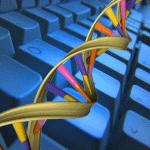Bioinformatics
|
3 february 2018 14:32:35 |
| Large scale ab initio modelling of structurally uncharacterized antimicrobial peptides reveals known and novel folds (Proteins: Structure, Function, and Bioinformatics) |
|
Tweet Antimicrobial resistance within a wide range of infectious agents is a severe and growing public health threat. Antimicrobial peptides (AMPs) are among the leading alternatives to current antibiotics, exhibiting broad spectrum activity. Their activity is determined by numerous properties such as cationic charge, amphipathicity, size and amino acid composition. Currently, only around 10% of known AMP sequences have experimentally solved structures. To improve our understanding of the AMP structural universe we have carried out large scale ab initio 3D modelling of structurally uncharacterised AMPs that revealed similarities between predicted folds of the modelled sequences and structures of characterized AMPs. Two of the peptides whose models matched known folds are Lebocin Peptide 1A (LP1A) and Odorranain M, predicted to form ?-hairpins but, interestingly, to lack the intramolecular disulfide bonds, cation-? or aromatic interactions that generally stabilise such AMP structures. Other examples include Ponericin Q42, Latarcin 4a, Kassinatuerin 1, Ceratotoxin D, and CPF-B1 peptide, which have ?-helical folds, as well as mixed ?? folds of human Histatin 2 peptide and Garvicin A which are, to the best of our knowledge, the first linear ??? fold AMPs lacking intramolecular disulfide bonds. In addition to fold matches to experimentally derived structures, unique folds were also obtained, namely for Microcin M and Ipomicin. These results help in understanding the range of protein scaffolds that naturally bear antimicrobial activity and may facilitate protein design efforts towards better AMPs. This article is protected by copyright. All rights reserved. |
| 223 viewsCategory: Biochemistry, Bioinformatics |
 Choosing non-redundant representative subsets of protein sequence data sets using submodular optimization (Proteins: Structure, Function, and Bioinformatics) Choosing non-redundant representative subsets of protein sequence data sets using submodular optimization (Proteins: Structure, Function, and Bioinformatics)Comparing side chain packing in soluble proteins, protein-protein interfaces, and transmembrane proteins (Proteins: Structure, Function, and Bioinformatics) 
|
| blog comments powered by Disqus |
MyJournals.org
The latest issues of all your favorite science journals on one page
The latest issues of all your favorite science journals on one page



